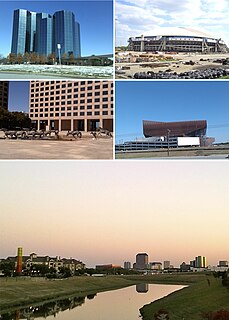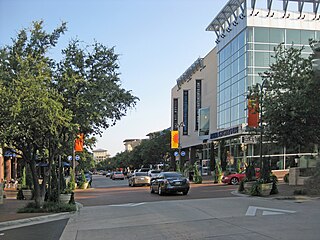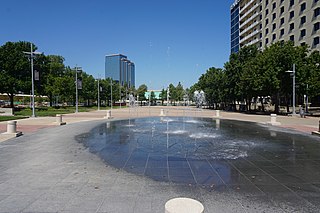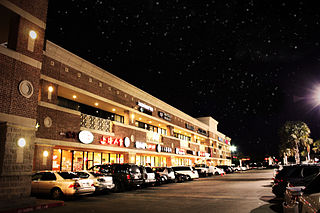
Dallas is the third largest city in Texas and the largest city in the Dallas–Fort Worth metroplex, the fourth-largest metropolitan area in the United States at 7.5 million people. It is the largest city in and seat of Dallas County in the U.S. state of Texas with portions extending into Collin, Denton, Kaufman and Rockwall counties. With a 2020 census population of 1,304,379, it is the ninth most-populous city in the U.S. and the third-largest in Texas after Houston and San Antonio. Located in the North Texas region, the city of Dallas is the main core of the largest metropolitan area in the southern United States and the largest inland metropolitan area in the U.S. that lacks any navigable link to the sea.

Irving is a city in the U.S. state of Texas. Located in Dallas County, it is also an inner ring suburb of Dallas. The city of Irving is part of the Dallas–Fort Worth metroplex. According to a 2019 estimate from the United States Census Bureau, the city population was 239,798, making it the thirteenth-most populous city in Texas, and 93rd most populous city in the U.S. Irving is noted for its racial and ethnic diversity, and has been ranked as one of the most diverse cities in the United States. Irving includes the Las Colinas mixed-use master-planned community and part of the Dallas/Fort Worth International Airport.

Frisco is a city in Collin and Denton counties in the U.S. state of Texas. It is part of the Dallas–Fort Worth metroplex and about 25 miles (40 km) from both Dallas Love Field and Dallas/Fort Worth International Airport. Its population was 200,509 at the 2020 U.S. census.

Plano is a city in Collin County and Denton County, Texas, United States. It had a population of 285,494 at the 2020 census. It is a principal city of the Dallas–Fort Worth metroplex.

Richardson is a city in Dallas and Collin counties in the U.S. state of Texas. As of the 2020 United States census, the city had a total population of 119,469. Richardson is an inner suburb of the city of Dallas.

The Dallas–Fort Worth metroplex, officially designated Dallas–Fort Worth–Arlington by the U.S. Office of Management and Budget, is a conurbated metropolitan statistical area in the U.S. state of Texas encompassing 11 counties and anchored by the major cities of Dallas and Fort Worth. It is the economic and cultural hub of North Texas. Residents of the area also refer to it as DFW, or the Metroplex. The Dallas–Fort Worth–Arlington metropolitan statistical area's population was 7,637,387 according to the U.S. Census Bureau's 2020 census, making it the most populous metropolitan area in both Texas and the Southern United States, the fourth-largest in the U.S., and the tenth-largest in the Americas. In 2016, the Dallas–Fort Worth metroplex had the highest annual population growth in the United States.

North Texas is a term used primarily by residents of Dallas, Fort Worth, and surrounding areas to describe much of the north central portion of the U.S. state of Texas. Residents of the Dallas–Fort Worth metroplex generally consider North Texas to include the area south of Oklahoma, east of Abilene, west of Paris, and north of Waco. A more precise term for this region would be the northern part of the central portion of Texas. It does not include the Panhandle of Texas, which expands further north than the region previously described, nor does it include most of the region near the northern border of Texas.

99 Ranch Market is an American supermarket chain owned by Tawa Supermarket Inc., which is based in Buena Park, California. 99 Ranch has 54 stores, primarily in California, with other stores in Nevada, Oregon, Washington, New Jersey, Texas, Maryland, Massachusetts, Arizona, and Virginia. The company also started offering shopping via its website in 2014. In February 2021, the company also launched their mobile app for grocery delivery.

Texas's 3rd congressional district of the United States House of Representatives is in the suburban areas north and northeast of Dallas. It encompasses much of Collin County, including McKinney, as well as parts of Plano and Frisco, and Prosper. Additionally, the district includes all but the southern portion of Hunt County. The district is also home to the public college Collin College.
This article is about the culture of Dallas, Texas (USA).
IndiaCo is an Indian-American retail chain that operates nine grocery stores and five restaurants in the Dallas-Fort Worth metroplex, one store in the Atlanta metropolitan area, and one shopping mall in Naperville, Illinois, the biggest Indian-American mall in the United States.

Chinatowns are enclaves of Chinese people outside of China. The first Chinatown in the United States was San Francisco's Chinatown in 1848, and many other Chinatowns were established in the 19th century by the Chinese diaspora on the West Coast. By 1875, Chinatowns had emerged in eastern cities such as New York City, Boston, and Philadelphia. In 1882, the Chinese Exclusion Act, which barred Chinese immigration to the United States, was passed into law. In 1943, the Magnuson Act repealed the Chinese Exclusion Act, and the population of Chinatowns began to rise again. In the 2010s, the downturn in the U.S. economy caused many Chinese Americans to return to China.

The Houston area population includes a large number of people with Chinese ancestral backgrounds. According to the American Community Survey, as of 2013, Greater Houston has 72,320 residents of Chinese origin.

There is a rapidly growing Mexican-American population in the Dallas-Fort Worth area.

As of the 2020 United States census, there were 7,637,387 people. The racial makeup of the MSA was 50.2% White, 15.4% African American, 0.6% Native American, 5.9% Asian, 0.1% Pacific Islander, 10.0% from other races, and 2.4% from two or more races. Hispanic or Latino of any race were 27.5% of the population.
The Dallas–Fort Worth area has one of the largest Nigerian American populations in the United States.
There is a significant population of American Muslims in the Dallas–Fort Worth metroplex. Dallas-Fort Worth is home to sixty-two Sunni mosques. According to AbdelRahman Murphy, a Chicago-born, Irving-based Islamic teacher and Muslim community leader, other U.S.-based Muslims now refer to Dallas as the "Medina of America". Not only is Dallas Masjid Al Islam the oldest Muslim community in the DFW area, it established the first mosque in the city of Dallas and established the first Muslim school in the DFW area. As of 2021, many major Muslim organizations and charities have headquarters or operations in DFW, mostly located in Richardson, Texas such as: ICNA Dallas, Muslim American Society, Muslim Legal Fund of America, Helping Hands for Relief & Development, Sabrina Memorial Foundation, Islamic Relief USA, CAIR-Texas, and MA’RUF. There are also several institutions of research and higher education such as: Qalam Institute (Carrollton), ISRA Foundation (Plano), Bayyina Academy (Euless), and The Islamic Seminary of America (Richardson). -
The Dallas–Fort Worth metroplex has 1.2 million African-Americans, the 2nd-largest metro population of African-Americans in Texas.











